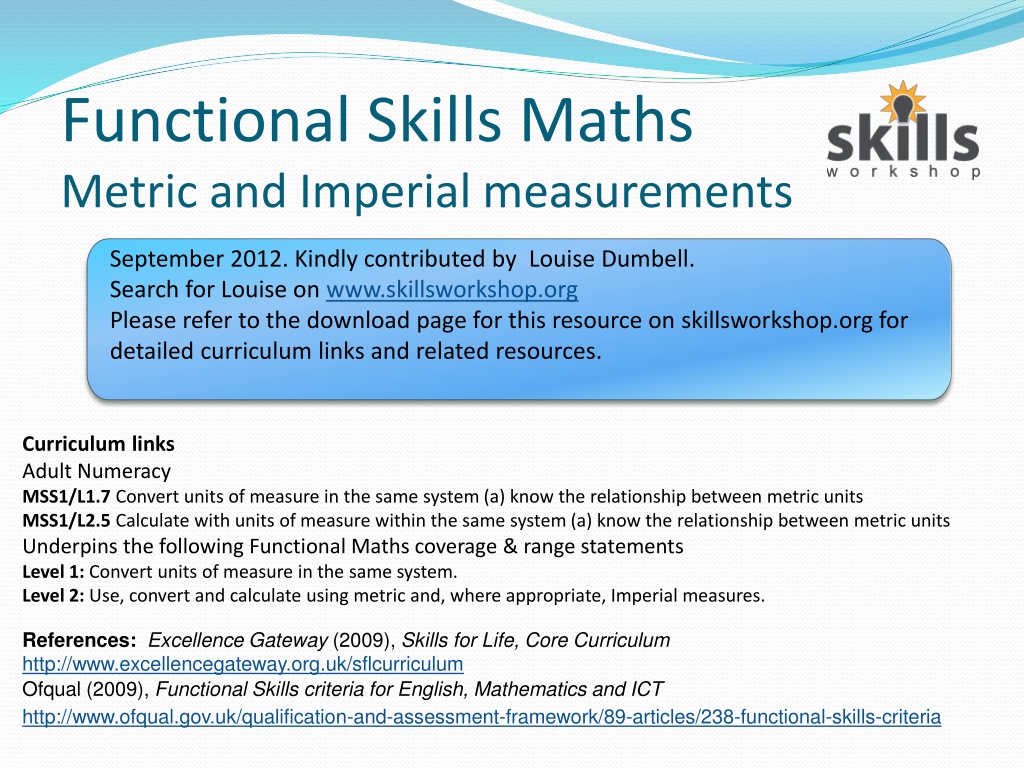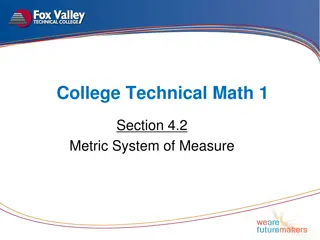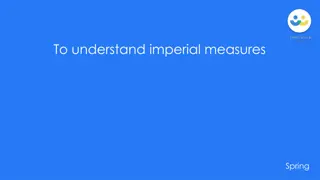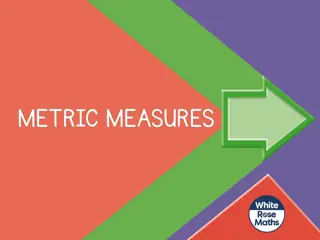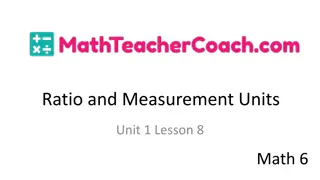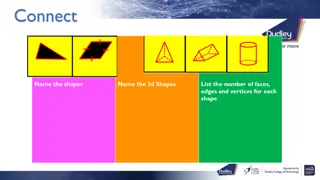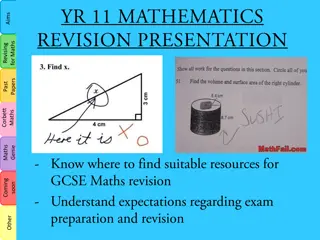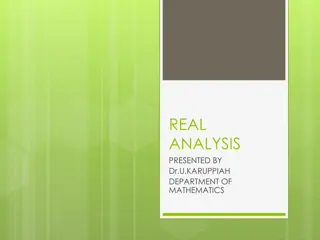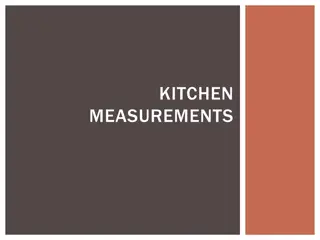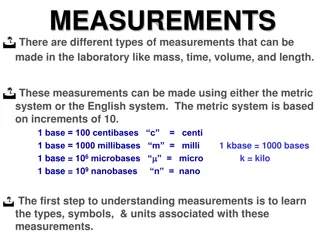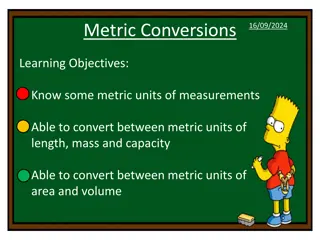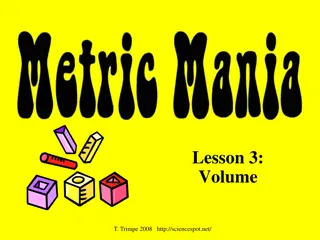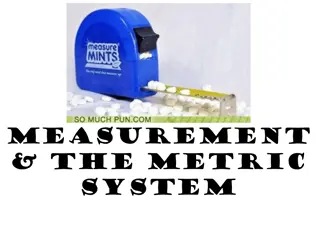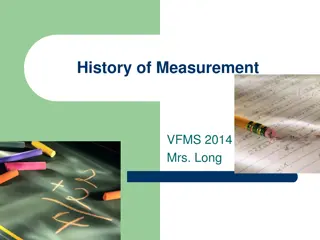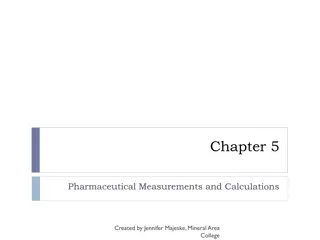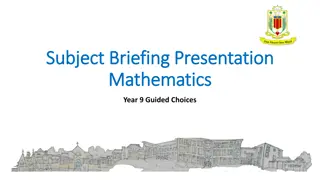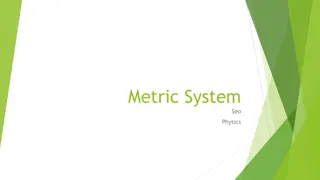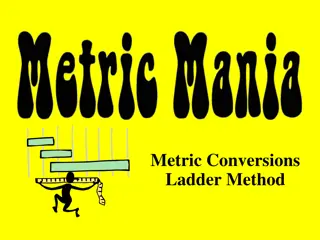Understanding Metric and Imperial Measurements in Maths
Explore the world of metric and imperial measurements in mathematics, covering units for length, mass, and capacity. Learn conversion rates and relationships between different units, enhancing your functional maths skills at levels 1 and 2. Discover the significance of milli-, centi-, and kilo- prefixes, as well as imperial units for length, mass, and capacity. Dive into conversion formulas between metric and imperial units, including length measurements. Enhance your numeracy skills through practical applications and exercises provided by this comprehensive resource.
Download Presentation

Please find below an Image/Link to download the presentation.
The content on the website is provided AS IS for your information and personal use only. It may not be sold, licensed, or shared on other websites without obtaining consent from the author. Download presentation by click this link. If you encounter any issues during the download, it is possible that the publisher has removed the file from their server.
E N D
Presentation Transcript
Description: swlogo Functional Skills Maths Metric and Imperial measurements September 2012. Kindly contributed by Louise Dumbell. Search for Louise on www.skillsworkshop.org Please refer to the download page for this resource on skillsworkshop.org for detailed curriculum links and related resources. Curriculum links Adult Numeracy MSS1/L1.7 Convert units of measure in the same system (a) know the relationship between metric units MSS1/L2.5 Calculate with units of measure within the same system (a) know the relationship between metric units Underpins the following Functional Maths coverage & range statements Level 1: Convert units of measure in the same system. Level 2: Use, convert and calculate using metric and, where appropriate, Imperial measures. References: Excellence Gateway (2009), Skills for Life, Core Curriculum http://www.excellencegateway.org.uk/sflcurriculum Ofqual (2009), Functional Skills criteria for English, Mathematics and ICT http://www.ofqual.gov.uk/qualification-and-assessment-framework/89-articles/238-functional-skills-criteria
Functional Skills - Maths Metric and Imperial Measurements
Metric Units of Measurement What metric units do we use for measuring length? kilometre, metre, centimetre, millimetre What metric units do we use for measuring mass? tonne, kilogram, gram What metric units do we use for measuring capacity? litre, centilitre, millilitre
Metric Units How many mm in 1 m? How many cm in 1 m? How many m in 1 km? How many mg in 1 g? How many g in 1 kg? How many kg in 1 tonne? How many ml in 1 cl? How many cl in 1l?
Metric Units milli means thousandth centi means hundredth kilo means one thousand
Imperial units What are Imperial units of length? inch, foot/feet, yard, mile 12 inches = 1 foot, 3 feet = 1 yard, 1760 yards = 1 mile
Imperial units What are imperial units of mass? Ounce (oz), pound (lb), stone, hundredweight (cwt), ton 16 oz = 1 lb, 14 lb = 1 stone, 8 stones in 1 cwt, 160 stone = 1 ton 20 cwt = 1 ton
Imperial units What are imperial units of capacity? Pint, gallon 8 pints = 1 gallon
Conversion between metric and imperial measurements - length. 1 centimetre = 0.394 inches 1 inch = 2.54 centimetres 1 metre = 3.281 feet 1 foot = 0.3048 metres = 30.48 cm 1 mile = 1.609 kilometres 1 kilometre = 0.621 mile
Conversion between metric and imperial measurements - mass. 1 gram = 0.035 ounces 1 ounce = 28.35 grams 1 pound = 0.45 kilograms 1 kilogram = 2.20 pounds 1 stone = 6.35 kilograms 1 kilogram = 0.156 stones
Conversion between metric and imperial measurements - capacity. 1 pint = 0.568 litres 1 litre = 1.760 pints 1 gallon = 4.546 litres 1 litre = 0.220 gallons
